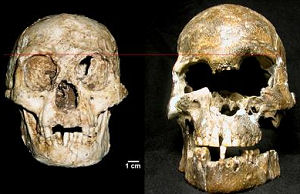6 August 2014
Flores' "hobbit" not a new human species, say detractors
by Will Parker
 Back in 2004, the excavation of unusual skeletal remains in Liang Bua cave on the island of Flores yielded what the discoverers claimed was "the most important find in human evolution for 100 years." But Homo floresiensis (nicknamed the hobbit) may not be a new human species at all, say the authors of a new paper appearing in the Proceedings of the National Academy of Sciences.
Back in 2004, the excavation of unusual skeletal remains in Liang Bua cave on the island of Flores yielded what the discoverers claimed was "the most important find in human evolution for 100 years." But Homo floresiensis (nicknamed the hobbit) may not be a new human species at all, say the authors of a new paper appearing in the Proceedings of the National Academy of Sciences.
The reanalysis of the remains was conducted by an international team of researchers that included Robert B. Eckhardt, a professor of developmental genetics from Penn State, who argues that the remains do not represent a new species at all. Rather, he claims it is the skeleton of a developmentally abnormal human exhibiting features most consistent with a diagnosis of Down syndrome.
Much of the initial excitement amongst anthropologists in 2004 stemmed from the hobbit's unusual anatomical characteristics. The reported cranial volume of only 380 milliliters (23.2 cubic inches) suggested a brain less than one third the size of an average modern human's; and its short thigh bone, which indicated the creature was only 1.06 meters (about 3.5 feet) tall.
But the new analysis disputes these figures. "The original figures for cranial volume and stature are underestimates, markedly lower than any later attempts to confirm them," said Eckhardt, who claims to have consistently found a cranial volume of about 430 milliliters (26.2 cubic inches).
Such a difference would be significant, as the revised figure falls in the range predicted for a modern human with Down syndrome from the same geographic region.
Eckhardt goes on to point out that the original estimate of 3.5 feet for the creature's height was based on extrapolation combining the short thigh bone with a formula derived from an African pygmy population. "But humans with Down syndrome also have diagnostically short thigh bones," he notes.
The new analysis also points to several other features that Eckhardt says indicate a developmental abnormality. "The first indicator is craniofacial asymmetry, a left-right mismatch of the skull that is characteristic of this [Down syndrome] and other disorders," he notes. Additionally, he argues that the short thigh bones not only match the height reduction seen in Down syndrome, but when corrected statistically for normal growth, yield a stature of about 1.26 meters, or just over four feet, a figure he says is matched by some humans now living on Flores.
"Are the skeletons from Liang Bua cave sufficiently unusual to require invention of a new human species? Our reanalysis shows that they are not," Eckhardt concludes. "The less strained explanation is a developmental disorder. Here the signs point rather clearly to Down syndrome, which occurs in more than one per thousand human births around the world."
Related:
Discuss this article in our forum
Size matters: evolutionary changes in body size measured
Down syndrome may be reversible
Software scans family photos to diagnose rare disorders
Source: Penn State
